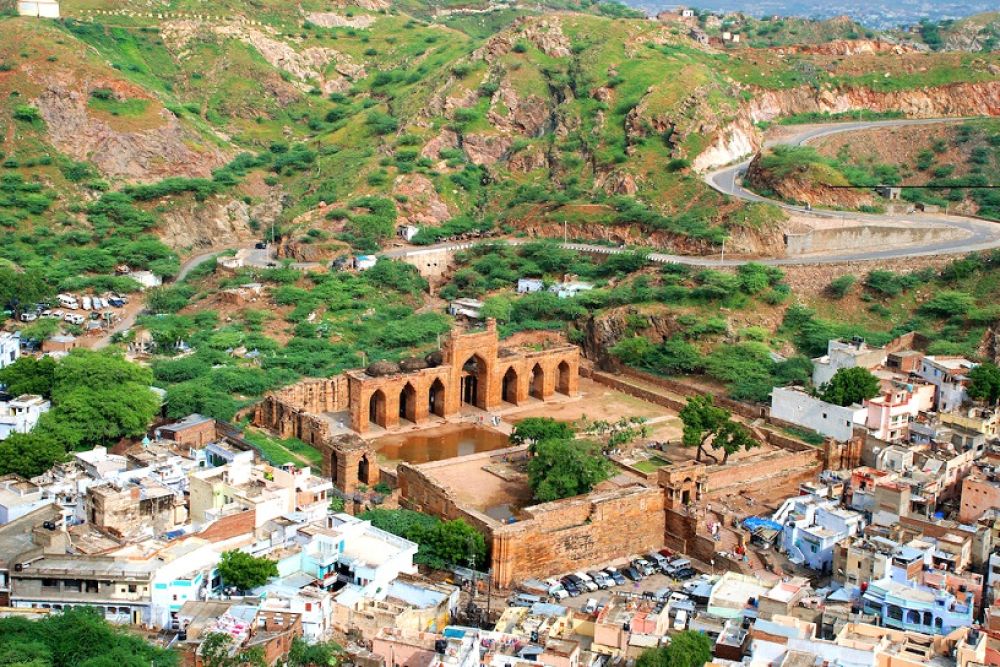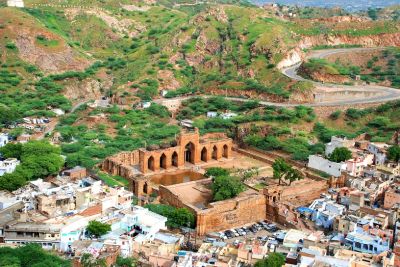

The Ajmer Sharif Dargah is the tomb of the Sufi saint Khwaja Moinuddin Chishti, who came to Ajmer from Persia in 1192. It is one of the most sacred shrines in India and a popular pilgrimage site for people from all faiths. The Dargah has a rich history and the architecture reflects Mughal influences with its marble pavements, delicate carvings, and gold-plated dome. Visitors are often awestruck by the peaceful ambiance, the intricate calligraphy, and the harmonious qawwalis (Sufi devotional music) that echo through the courtyard. Pilgrims tie threads to the shrine's marble screens to make a wish and offer chadar (sacred cloth) and flowers. The Dargah is also known for its Urs festival, which commemorates the death anniversary of the saint with six days of festivities, drawing hundreds of thousands of devotees. When visiting, it is important to dress modestly and respect the religious customs of the shrine.
Adhai Din Ka Jhonpra is a historical mosque situated in Ajmer, which translates to 'Shed of 2½ Days'. It was originally constructed as a Sanskrit college but was converted into a mosque by Qutub-ud-Din-Aibak, upon his conquest of Ajmer. The mosque is a fine example of Indo-Islamic architecture, especially known for its seven arched walls inscribed with Islamic calligraphy and verses from the Quran. The name of the mosque is associated with a legend that it was constructed in two and a half days. The elaborate screen of arches within the mosque is a stunning sight and is considered an architectural marvel of its time. The structure blends elements from Jain and Hindu temple architecture, reflecting the diverse history of the region. Adhai Din Ka Jhonpra is a must-visit for history buffs and those interested in the cultural syncretism of medieval India.
Akbar's Palace, built in 1570, is one of Ajmer's historical landmarks that served as a residence for Emperor Akbar when he visited the city. Today, the palace has been converted into a museum that houses a rich collection of Mughal and Rajput armor, as well as sculptures that date back to the 8th century. Visitors get an insight into the grandeur of Mughal architecture and can appreciate the robust sandstone construction of the palace. The museum displays ancient rock inscriptions, a variety of marbles, coins from different periods, and artifacts that throw light on the region's history. While strolling through the palace, one can imagine the bygone era of emperors and battles, making it a fascinating experience for those interested in exploring the cultural heritage of Ajmer.
Ana Sagar Lake is an artificial lake named after the ruler Anaji Chauhan who developed it in the 12th century. This picturesque lake spreads over 13 kilometers and is the heart of Ajmer, providing a perfect setting for a tranquil boat ride. The scenic beauty of the lake, surrounded by the Aravalli mountains, makes for an ideal spot to unwind and enjoy the serene atmosphere. Visitors can rent a boat and sail into the sunset, which casts a golden glow over the marble pavilions known as Baradari, built by Shah Jahan. There are walking paths, a park, and small eateries around the lake, making it a popular spot for both tourists and locals. The Daulat Bagh gardens near the lake are another must-visit area for a leisurely stroll amidst lush greenery.
The Taragarh Fort, also known as Star Fort, stands majestically atop a hill overlooking the city of Ajmer. It is one of the oldest forts in India, constructed in the early 12th century by the Chauhan ruler, Ajaypal Chauhan. The ascent to the fort offers panoramic views of the surrounding area and the fort itself is a testament to the grandiose military architecture of the Rajputs. With its massive bastions and three gateways, the fort is an adventurer's delight and a haven for photographers. The fort complex includes the Miran Saheb ki Dargah, which is the site of the grave of a governor of the fort who died in battle. Although in ruins, the fort's historical significance and the views it offers make the hike up incredibly rewarding. Exploring Taragarh Fort is a journey back in time and an opportunity to engage with Ajmer's rich past.
The Naya Bazaar is a vibrant market located in the heart of Ajmer and is a treasure trove for shoppers. The bustling lanes of this market offer a variety of goods ranging from traditional Rajasthani textiles and clothing to jewelry and handicrafts. Here, one can find a wide selection of colorful Bandhani (tie-dye) and Leheriya fabrics, which are specialty products of the state. The market also has a number of shops where you can buy silver adornments, mojari (traditional Rajasthani footwear), and trinkets to take back as souvenirs. Foodies can indulge in local snacks and sweets like the famous Sohan Halwa and Kachoris. Shopping at Naya Bazaar is not just about the purchases, it's an immersive experience into the local culture and the daily life of the people of Ajmer.
Soniji Ki Nasiyan, also known as the Ajmer Jain Temple, is renowned for its stunning architecture and intricate gold work. It was built in the late nineteenth century and is dedicated to Lord Rishabhdev, the first Tirthankara of Jainism. The main chamber, known as the Swarna Nagari or 'City of Gold', contains several gold-plated wooden figures depicting scenes from Jain mythology. The craftsmanship and attention to detail in the representations of the ancient Jain cities are extraordinary, presenting a visual treat to visitors. The temple is an exemplary piece of Jain art and culture, attracting architecture enthusiasts and spiritual seekers alike. The peaceful ambiance of the temple offers a calming respite from the bustling city outside, making it a must-visit for those in search of spiritual solace or an appreciation for religious artistry.
Foy Sagar Lake is a picturesque artificial lake situated at the outskirts of Ajmer. It was created in the year 1892 as a part of a famine relief project by an English engineer, Mr. Foy. This tranquil spot is ideal for those seeking a quiet place to relax and enjoy the natural beauty of the surroundings. The lake offers a perfect setting for picnics, bird watching, and photography, especially during sunrise or sunset when the sky is awash with colors. The panoramic view of the Aravalli hills on one side and the reflection of the sky in the calm water creates a breathtaking scene. There are no major water activities at Foy Sagar Lake, but its peaceful environment makes it a preferred destination for a short getaway from the city's hustle-bustle.
Mayo College is one of the oldest public boarding schools in India, founded in 1875 with the intention of providing the leaders of the princely states with an English-style education. The college museum, set within the school grounds in a splendid building, showcases a collection that provides insights into the history of the school and the princely states of Rajputana. The museum features vintage photographs, silver trophies, old school records, and a variety of artifacts related to the region's history and culture. The architecture of the museum, with its Indo-Saracenic style, is admirable and worth a visit in itself. Access to the museum might be limited due to school terms and visitor policies, so it's advisable to check for visitor hours or to arrange a visit in advance.
St. Mary's Church is a lesser-known tourist attraction in Ajmer, yet it stands out for its peaceful environment and striking European-inspired architecture. The church, built in 1853 by the British during their rule in India, features Gothic style architecture with beautiful stained glass windows and sharp spires that point towards the sky. As one of the oldest churches in Rajasthan, St. Mary's Church provides a quiet retreat for visitors to sit and reflect or to admire the architectural beauty. Open to all, irrespective of one's faith, the church premises radiate a calming influence and is an ideal spot for those seeking a moment of solace during their travels around Ajmer.
